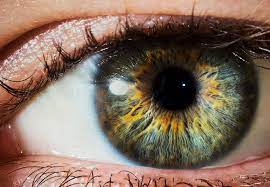Eyes are a mirror of the soul What feelings can a look express? Is it possible to guess a person’s intentions from his eyes? How does the eye react to different emotions? We will explain these and other things in this article. The human appearance, body and facial expressions are able to convey any emotion. And yet, if people have learned to control facial expressions and body movements to hide their true feelings, then it is almost impossible to control eye expressions. What the eyes say – learn their language Our eyes will tell and reveal exactly what a person feels or thinks at the moment. No wonder there is a judgment that the eyes are the mirror of the soul. You can find out a lot about how often your interlocutor looks at you, as well as where exactly he directs his gaze. In psychology, several types of views are defined, each of which shows the nature of relationships between people.
If, for example, the gaze is focused on the eye-bridge-forehead area, it shows a business connection, maintains a serious, working atmosphere during a conversation. The so-called social view characterizes more friendly, calm communication, while the interlocutor looks in the area of the “eyeballs”. If the interlocutor looks in the eyes and below – in the chest, it shows his sexual interest and such a look is called intimate. Knowing the above subtleties accepted in our culture, you can understand how a person treats you – as a friend, employee or sees you as an attractive person of the opposite sex.
The direction of the interlocutor’s gaze speaks volumes
However, social norms of communication are different for different nations. For example, among the Japanese it is considered acceptable to direct your gaze to the neck, and direct face-to-face contact is considered unacceptable. Therefore, in an attempt to interpret the behavior of the interlocutor, it is always good to remember his national characteristics.
The direction of the gaze can also tell about the feelings of the listener or interlocutor. So, if the speaker averts his eyes during a conversation, it may signal that he is: hiding some information; not sure what he says; lies; And if the listener carefully looks away, most often it shows that he: does not completely agree with the speaker; doubts his words; does not want feelings (shame, resentment, disagreement, etc.) to be visible; The most obvious example of life is children. When they quarrel, they almost always hide their eyes: or look down. Duration of the gaze When making eye contact with strangers (on the street, in public transport, shops, etc.), one tends to look away, as open viewing is uncomfortable for most of us. Strangers look at each other for a moment and a long look is considered a challenge. This can be either a sign of sympathy or covert aggression. The fact is that in the animal kingdom, a long and insistent look means the same thing. It is believed that the gaze should be held for no more than 3 seconds. If he is detained for more, it causes the interlocutor uncomfortable feelings and is perceived as a signal of danger. This approach is used by experienced manipulators to unbalance a person and deprive him of confidence. When the gaze changes its direction too quickly, psychologists explain this reaction as strong excitement, secrecy, cunning, dishonesty, shame, fear or just proof of boredom.
Pupil size
Surprisingly, even the size of the pupils can say a lot about the interlocutor. One cannot consciously control the changes in the pupils, so their reaction will betray one’s true feelings. From joy, excitement, sexual interest in a person, the pupils dilate. In addition, dilated pupils are considered an indirect sign of trust in the interlocutor. The bent pupils “speak” of hostility, fear, aggression or irritation. When trying to interpret human behavior, we should not forget about the natural contraction of the pupils in bright light and their dilation in the dark, as well as when taking certain drugs. In general, the size of the pupils can say a lot about the interlocutor.
The color of the iris
According to esoterics, even a person’s character can be recognized by the color of his eyes. For the owners of blue eyes we can say that they are romantic, dreamy, sentimental, but at the same time they are very touchy and vulnerable. Green-eyed people are assertive, sensible and purposeful. Curiosity, restraint and perseverance characterize gray-eyed individuals. The browns have energy in their character, entrepreneurship, they are gambling personalities, they show a thirst for power. If the color of the iris is ambiguous and combines several shades – such as gray and green, then their owner has characteristics of both colors. The degree of expression of each trait in the character directly depends on the intensity of the color.












